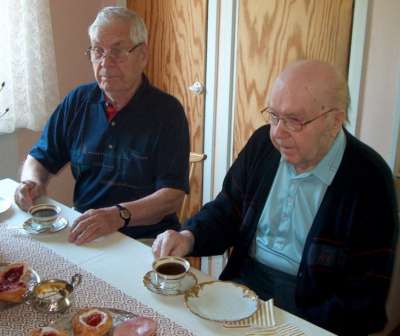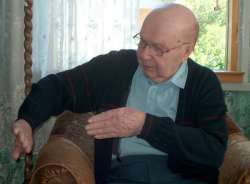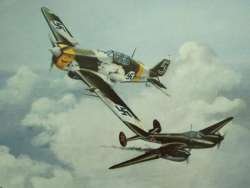I and two other associates interviewed the Morane Saulnier 406/Me 109 ace Antti Tani and Brewster/109 ace Jouko Huotari last autumm. I received today the English translation of the interview and here's some snippets of what's to come.
Please visit for more:
Finnish Virtual Pilots Association Aviation History
Q. As we said there are numerous questions about Moranes and operating them. One was about the armament and what was done with it in Finland. As the Moranes were received, they were equipped with French 7.5mm machine guns mainly, and some of them with the 20mm Hispano-Suiza cannon, weren't they ? How many cannons were installed?
Antti Tani: I should say less than half of the number of aircraft, scarcely more. I, for one, flew a fighter equipped with small arms all through the beginning phase of the war. Then I scored enough so that the commander ordered a cannon to be given to me. It was the commander of the Flying Regiment, Col.Lorenz himself, who gave the order for the cannon installation.
Q. As far as we know the cannon was in some respect unreliable. It is said that the trigger mechanism could jam totally, or it fired only one shell and then jammed.
Antti Tani: It is true that it was a fairly ungrateful device. The 12.7mm machine gun that was introduced later was much better. It worked. Also the ammo capacity (of the cannon) was unreasonably small, it was, let me think, 50 shells. You could spend it in a couple of seconds. One burst, missing the target by accident, and the ammunition was spent. You then had to do with the wing guns and they were what they were. At the beginning of the war you could hit something with them, because the barrels were not full of sand. But after the Moranes took off from Naarajärvi for example, there was so much dust in the air that the next one had to wait for half an hour almost - if the weather was calm, you could not see anything.
The sand penetrated in the gun barrels and they were so worn out that you could hit anything with luck only. The barrels were so wide that a bullet dropped in the barrel went clinking down through it. The armourers were angry but what could they do? They could not do anything once the gun barrels were worn wide. The weapons that were fired wore out fairly fast.
Q. How were your weapons harmonized in general, how far or how near ?
Antti Tani: The wing guns were harmonized to 100m with the cannon.
Jussi Huotari: The BW had the two heavy 12.7mm wing guns. They were harmonized to two hundred fifty meters. Or farther maybe ?
Antti Tani: Weren't they mounted almost in the fuselage?
Jussi Huotari: As far as I can remember there was one heavy on the top of the fuselage and then one light gun for training, so to say. For target practice. The wing guns were heavy ones. They were harmonized to two hundred and fifty meters.
Q. Was this 250 meters applied to your aircraft only or was it the standard ?
Antti Tani: It was the standard.
Q. So it was the standard. You, Mr. Tani, had your weapons harmonized for 100m but you had smaller caliber guns with more curved bullet trajectory.
Antti Tani: That is how it is. The wing guns used to be harmonized for a longer range but at least I had them set for 100 meters because I did not want to shoot at a long range. You had to get next to the target and shoot, because then you could see if it had any effect. Shooting from 250 m would have been like throwing peas. I had that sort of idea.
Q. Throwing peas, yet the gun caliber was about the same as the British fighters had. Was 100m an efficient range for a small caliber machine gun?
Antti Tani: There is some effect at 200m but at a range of 100m there is much more effect. The fact is that when I fire my guns and the target aircraft in front of me has a speed of 500 kmh, the target will have moved far more than 100m before the bullet reaches the target. In fact the range is longer than it appears. If you shoot at a range of 250 m ... the bullet does fly quite fast but the range is relatively longer.
Q. Then there is the scattering factor...
Antti Tani: Scattering and barrel vibration factors. Actually the projectile density is very low. The shorter the firing distance is, the smaller the scatter is. As the range shortens, the scattering diminishes.
Q. There is an incident mentioned in the book , where you engaged a plane and fired it with your cannon "at a long range. Was 150m a long range for a cannon ?
Antti Tani: The longest range ever was when I fired at that Pe-2 above Äanislinna (Petrozavodsk) at 500m. The deflection was so large that I did not use the gunsight but used the cockpit canopy frame for deflection. Three bursts I fired, first aiming with the edge of the gunsight, then I aimed between the gunsight and the canopy frame and finally at the frame. Then I did hit him. The pilot took a bullet through his head and that was it.
Let us shoot at fighters only, to keep our style" .- Juutilainen
Jussi Huotari: It would have been always easier to shoot at bombers, but Illu Juutilainen said that let us shoot at fighters only, to keep our style. Let us shoot at fighters only.
Q: Illu Juutilainen was a kind of artist, wasn't he?
Antti Tani: He was a kind of artist really.
Jussi Huotari: We used to fly in pair with Illu for a couple of years. Then he was posted in the 34.
Q. He wanted to fight against fighters only?
Jussi Huotari: Yes
Q. Bombers were too easy for him ?
Jussi Huotari: Bombers were too easy.
Antti Tani: A bomber would fly straight. You just had to dive after them and open fire. Engaging a fighter you had to do something else than flying straight.
Jussi Huotari: Once I saw when we were on a patrol, our 3rd Flight. We were flying at ease as four bombers appeared, flying in the same direction. It was not long before each of them had one of us behind the tail and the bombers were in the forest. It was a rapid action, I never saw better in TV fiction.
Q. Were you flying Messerschmitts?
Jussi Huotari: No, Brewsters. Those bombers were on a platter, each of the fighter pilots just picked his own.
Jussi Huotari and deflection shooting

Antti Tani vs Pe-2:
